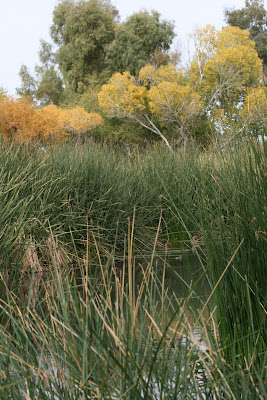 Buenos Aires is a sea of grass but it is also miles of streamside riparian habitat. The 118,000 acres is a rich combination of grassland, wetland, cottonwood lined streams and sycamore/oak mountain canyons.
Buenos Aires is a sea of grass but it is also miles of streamside riparian habitat. The 118,000 acres is a rich combination of grassland, wetland, cottonwood lined streams and sycamore/oak mountain canyons. This female Masked Bobwhite is one of only two that I spotted during my 5 hour visit. This highly endangered bird is being bred in captivity on the refuge and released into the wild.
This female Masked Bobwhite is one of only two that I spotted during my 5 hour visit. This highly endangered bird is being bred in captivity on the refuge and released into the wild. The trip yielded approximately 25 hawks including Red Tailed Hawks and American Kestrels. I kept an eye out for an Aplomado Falcon which is a local resident in the area
The trip yielded approximately 25 hawks including Red Tailed Hawks and American Kestrels. I kept an eye out for an Aplomado Falcon which is a local resident in the area.
 Buenos Aires used to be a cattle ranch and there are many old remnants of that era including what I think were stock yards.
Buenos Aires used to be a cattle ranch and there are many old remnants of that era including what I think were stock yards. While searching in vain to see the Pronghorn I spotted this lone coyote.
While searching in vain to see the Pronghorn I spotted this lone coyote. On my second trip around Pronghorn Drive I spotted this Mule Deer and three others feeding about a hundred yards off the road.
On my second trip around Pronghorn Drive I spotted this Mule Deer and three others feeding about a hundred yards off the road. The entire time I was at the refuge it stayed at 36 degrees with a cool breeze. It's hard to look for movement when the entire landscape is swaying in the wind however it was so peaceful that I hardly noticed the cold.
The entire time I was at the refuge it stayed at 36 degrees with a cool breeze. It's hard to look for movement when the entire landscape is swaying in the wind however it was so peaceful that I hardly noticed the cold. Mesquite trees dot the landscape but are not native plants at this location. Prescribed burns are being used to remove the Mesquite in an effort to return to a more natural environment. Habitat restoration is the major focus of the refuge's effort to return to the open, semi-desert grasslands of pre-settlement times.
Mesquite trees dot the landscape but are not native plants at this location. Prescribed burns are being used to remove the Mesquite in an effort to return to a more natural environment. Habitat restoration is the major focus of the refuge's effort to return to the open, semi-desert grasslands of pre-settlement times. It was extremely quiet the entire time I was there and I saw very few other human beings except when I stopped at the refuge headquarters where they were friendly and helpful. I have yet to visit the riparian areas at Arivaca Creek and Arivaca Cienega or Brown Canyon but I will definitely put them on the schedule in the near future.
It was extremely quiet the entire time I was there and I saw very few other human beings except when I stopped at the refuge headquarters where they were friendly and helpful. I have yet to visit the riparian areas at Arivaca Creek and Arivaca Cienega or Brown Canyon but I will definitely put them on the schedule in the near future.
This closes out my 100th post here on Sonoran Connection as well as my last post of 2009. I am grateful to those of you who have spent time here and I hope you have found it both interesting and educational. I look forward to an even more exciting 2010 traveling through the Sonoran Desert. Happy New Year!

























































